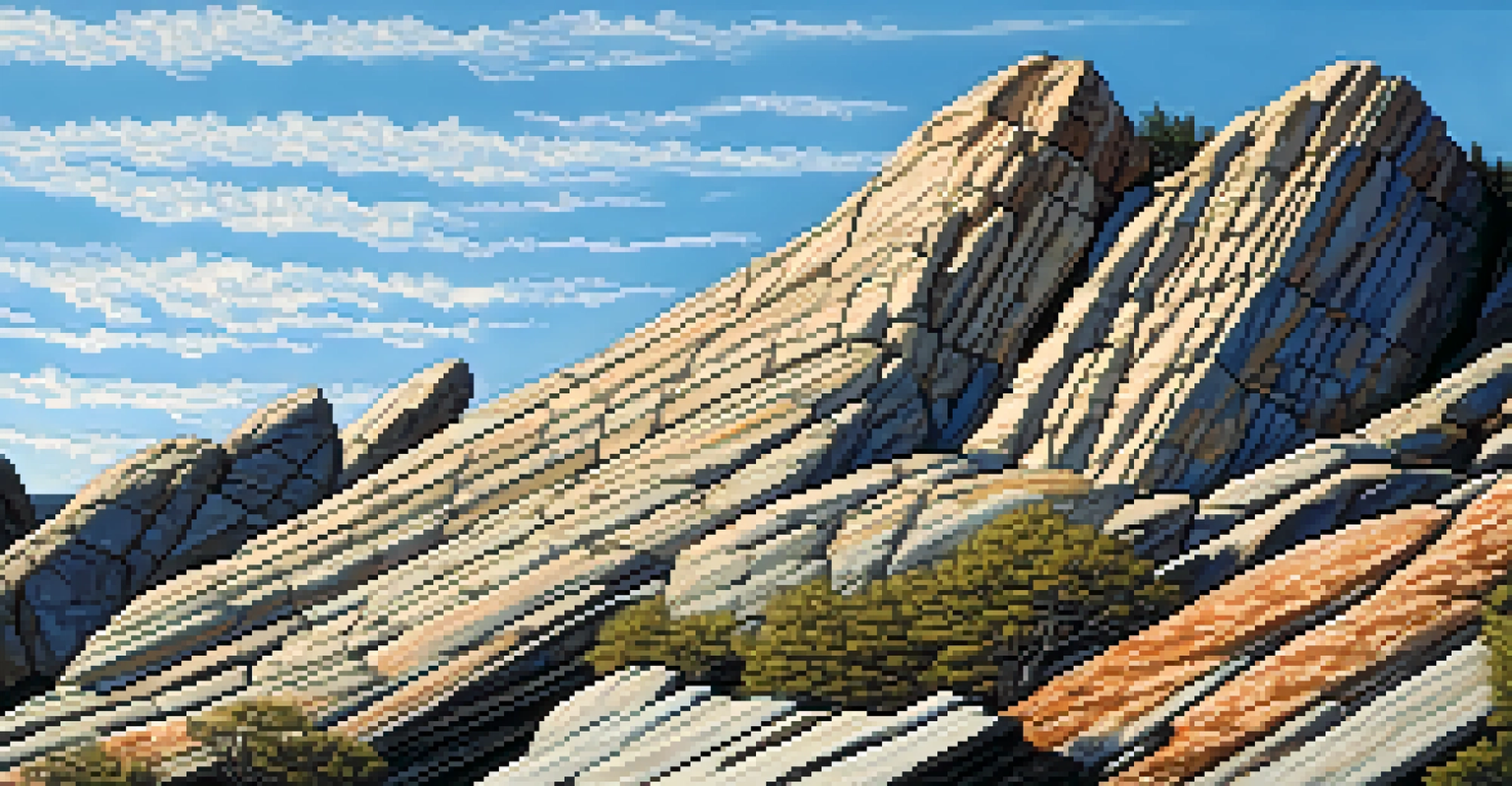New York's Geological History: Mountains to Urban Areas

The Ancient Origins of New York's Landscape
New York's geological history begins over a billion years ago, with the formation of ancient mountains. These mountains were part of a larger landmass known as Laurentia, which has since eroded significantly. Imagine these towering peaks, much like the Himalayas today, dominating the skyline of a prehistoric world.
The land is a living entity; it has a memory, a history, and a story to tell.
As tectonic plates shifted and collided, they shaped the land, creating what we now recognize as the Adirondack Mountains. This process not only formed mountains but also led to the development of various rock types, including granite and gneiss. Each rock layer tells a story of the earth's tumultuous past, providing insight into the forces that shaped New York.
Today, remnants of these ancient mountains can still be seen, particularly in the northern regions of the state. The beauty of these landscapes is not just scenic; they are a testament to the powerful geological forces at play millions of years ago.
Glacial Influence on New York's Geography
Fast forward to the last Ice Age, around 20,000 years ago, when massive glaciers carved out much of New York's terrain. These glaciers created valleys, lakes, and the unique topography we see today. Think of them as gigantic sculptors, shaping the land with their icy hands.

As the glaciers advanced and retreated, they left behind a rich array of geological features, including the Finger Lakes and the Great Lakes. The landscape was transformed from rugged mountains into a mosaic of water and rolling hills. This glacial activity not only altered the geography but also enriched the soil, making it fertile for agriculture.
Geological Forces Shaped New York
The ancient mountains and glacial activity have created the diverse landscapes we see in New York today.
Today, the lakes and valleys formed by glacial movement are integral to New York's identity, providing recreational opportunities and natural beauty. They remind us of the power of nature and its ability to reshape the earth.
The Rise of Urban Areas: A Geological Perspective
As New York transitioned from a rural to an urban landscape, the geological foundation played a crucial role. The bedrock, primarily composed of schist and gneiss, provided a solid base for skyscrapers and infrastructure. This stability has allowed New York City to grow into one of the world's largest urban centers.
In every walk with nature, one receives far more than he seeks.
However, the city's growth has not come without challenges. The geology of New York has influenced construction techniques and urban planning. For instance, the presence of soft sediments in certain areas necessitates unique engineering solutions to prevent structural issues.
Despite these challenges, the city's geological diversity contributes to its character and resilience. From Central Park's rocky outcrops to the waterfronts that line the Hudson River, the land tells a story of both natural beauty and human ingenuity.
The Role of Rivers in Shaping New York's Geography
Rivers have been instrumental in shaping New York's landscape and its development. The Hudson River, for example, carved through the mountains, creating stunning valleys and fertile plains. This natural waterway not only provided a route for transportation but also influenced settlement patterns.
The Erie Canal, constructed in the 19th century, further transformed the region. By connecting the Hudson River to the Great Lakes, it opened up trade routes and facilitated economic growth. Imagine the bustling activity as goods flowed through this man-made marvel, forever altering New York's economic landscape.
Rivers Influence Development
Rivers like the Hudson and the Erie Canal have played a crucial role in shaping transportation and settlement patterns in New York.
Today, New York's rivers continue to play a vital role in the ecosystem and urban life. They serve as recreational spaces, wildlife habitats, and vital resources for the city's inhabitants, showcasing the enduring impact of these waterways on the region.
The Impact of Erosion on New York's Landscape
Erosion is a powerful force that has shaped New York's landscape over millions of years. Wind, water, and ice have all contributed to the gradual wearing down of mountains and the redistribution of soil. This natural process can be likened to a slow artist, gradually sculpting the land into its current form.
While erosion creates stunning landscapes, it also poses challenges. Coastal areas, for example, are increasingly vulnerable to erosion due to rising sea levels and human activity. The need for effective management strategies has never been more crucial to protect these vital ecosystems.
Understanding erosion helps us appreciate the dynamic nature of New York's geography. It reminds us that the land is constantly changing, and we must adapt our practices to preserve its beauty for future generations.
Mining and Natural Resources in New York's Geological History
New York's geological diversity has made it rich in natural resources, including minerals and fossil fuels. Mining activities date back to the early settlers who extracted resources to build their communities. Picture bustling mining towns, where workers dug into the earth to unearth valuable materials.
The state is known for its production of salt, gypsum, and various metals, which have significantly contributed to its economy. While mining has its benefits, it also raises questions about environmental sustainability and land use. Balancing resource extraction with ecological preservation is a challenge that continues to this day.
Importance of Geological Preservation
Preserving New York's geological heritage is essential for future generations to appreciate and learn from the state's natural landscapes.
As we look to the future, the responsible management of these resources is essential. By understanding the geological foundations of New York, we can make informed decisions about how to utilize these materials while protecting the environment.
Preserving New York's Geological Heritage
As we explore New York's geological history, the importance of preservation becomes clear. The state's diverse landscapes, from the Adirondacks to urban areas, are not just scenic; they are part of our shared heritage. Protecting these areas ensures future generations can appreciate their beauty and understand their significance.
State parks, nature reserves, and geological sites play a crucial role in conservation efforts. They provide opportunities for education and recreation, allowing visitors to connect with the natural world. Think of these spaces as living museums, where the earth's history is on display for all to see.

Ultimately, preserving New York's geological heritage is a collective responsibility. By valuing and protecting our natural landscapes, we can foster a deeper connection to the land and inspire stewardship for years to come.